- Brazilian Rosewood back and sides
- Engelmann spruce top
- 000 size
- 25.34 scale length
- Easily accommodates Medium or Heavy strings
- Hybrid ladder laminated bracing with Carbon fiber “Tone tubes”
- Mahogany neck
- Slotted headstock
- Golden Age tuners
- Ebony fingerboard with MOP dots
- Pyramid bridge
- Tortoise body binding
- Lacquer finish
-
 Very few modern luthiers have captured that Larson Brothers sustain and what I call “shimmer” with a new build. This guitar, built by the master luthier Hans Brentrup in late 2009, has it in spades. We’ve never played anything but a 30’s Larson Bros’ that has the sustain this guitar has. Hans’ unique tone bars do what only the Larson tone bar system did– get the body of the guitar to sustain and impart that wonderful shimmer to the trebles especially.
Very few modern luthiers have captured that Larson Brothers sustain and what I call “shimmer” with a new build. This guitar, built by the master luthier Hans Brentrup in late 2009, has it in spades. We’ve never played anything but a 30’s Larson Bros’ that has the sustain this guitar has. Hans’ unique tone bars do what only the Larson tone bar system did– get the body of the guitar to sustain and impart that wonderful shimmer to the trebles especially. -
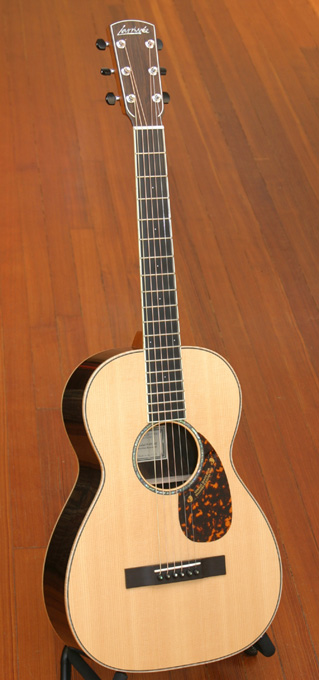 Mint condition. Period. Exceptional Larrivee 12-fret parlor guitar with a straight grained Sitka Spruce top and beautifully figured Brazilian Rosewood back & sides. Part of a very limited run of guitars built of high grade old stock Brazilian rosewood. Abalone rosette and tortoise shell pickguard. Ebony bridge w/ compensated saddle. Mahogany neck w/ microdot inlays, ivoroid bound ebony fingerboard, 1-3/4" nut, 24-1/4" scale, 13-1/4" lower bout, Larrivee logo peghead inlay, chrome tuners w/ebony buttons.
Mint condition. Period. Exceptional Larrivee 12-fret parlor guitar with a straight grained Sitka Spruce top and beautifully figured Brazilian Rosewood back & sides. Part of a very limited run of guitars built of high grade old stock Brazilian rosewood. Abalone rosette and tortoise shell pickguard. Ebony bridge w/ compensated saddle. Mahogany neck w/ microdot inlays, ivoroid bound ebony fingerboard, 1-3/4" nut, 24-1/4" scale, 13-1/4" lower bout, Larrivee logo peghead inlay, chrome tuners w/ebony buttons. -
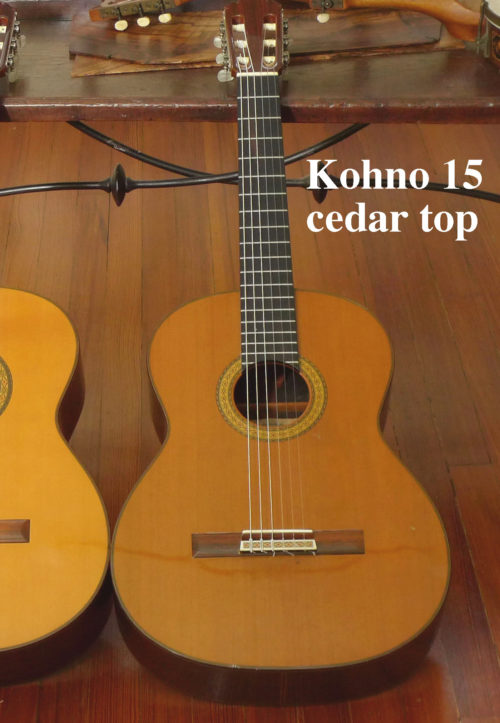 Kohno Classical Guitar. 1976 This instrument is being sold for a customer in Houston with a large collection of guitars. This guitar was originally purchased from VintageAmericanGuitar some five years ago– and its tone has aged and improved. The original Kohno design was specifically different from the high-end Spanish "concert" guitars of the day which had high action and beefy necks (and often long 664 or longer scale lengths). The Kohno necks were moderately thin in profile and shaped for very fluid playability. They’re a joy to play, physically. The 660 scale length– not overly long to begin with– actually “feels” shorter because of the neck design. (And the string spacing at the 2-inch nut: 1 11/16 inches, is also a great feature that adds to the great left hand feel.) We’ve seen/played many Kohnos– this one is unique in the combination of woods, and tone. Cedar top (not spruce), and Indian Rosewood back and sides. The combination, and this guitar’s age and unique voicing produce a dark, bass-rich tone and super clear and strong mids rarely found in a Kohno. It’s louder, darker and deeper than other Kohnos, yet is has great string separation– and the high E string is bell-like and loud.
Kohno Classical Guitar. 1976 This instrument is being sold for a customer in Houston with a large collection of guitars. This guitar was originally purchased from VintageAmericanGuitar some five years ago– and its tone has aged and improved. The original Kohno design was specifically different from the high-end Spanish "concert" guitars of the day which had high action and beefy necks (and often long 664 or longer scale lengths). The Kohno necks were moderately thin in profile and shaped for very fluid playability. They’re a joy to play, physically. The 660 scale length– not overly long to begin with– actually “feels” shorter because of the neck design. (And the string spacing at the 2-inch nut: 1 11/16 inches, is also a great feature that adds to the great left hand feel.) We’ve seen/played many Kohnos– this one is unique in the combination of woods, and tone. Cedar top (not spruce), and Indian Rosewood back and sides. The combination, and this guitar’s age and unique voicing produce a dark, bass-rich tone and super clear and strong mids rarely found in a Kohno. It’s louder, darker and deeper than other Kohnos, yet is has great string separation– and the high E string is bell-like and loud.- Solid Cedar top
- Solid Indian rosewood back and sides.
- Mahogany neck with 2 ebony strips
- Ebony fretboard
- 19 frets
- Rosewood bridge
- Gold engraved Fostero tuners. Fustero tuners are individually made by hand in Spain from the best materials…for decades they have adorned high end instruments built by Fleta, Ramirez, Kohno, Contreras, Bernabe and others.
- 660mm scale length
- 2" nut width
- String spacing at the nut: 1 11/16 inch
- Condition: One, repaired cracks:4 1/2 inches long, about 2 inches to the north (bass side) of the fretboard extension over the body.
-
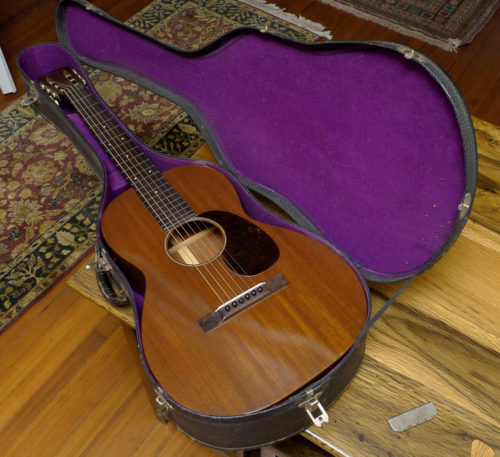 If there is a better-preserved Martin guitar from 1937, we have not seen it. This instrument is as an almost time-capsule condition 0-17H, still in its original case. And of course with its original Hawaiian set up. Many people convert these pre-war Martin Hawaiian set up guitars, to “Spanish” style, i.e. regular steel-string flat top set up. And that is certainly an option for whoever acquires this instrument. But this example, is just too nice, and too original for us to want to convert it. And the tone is exquisite (On request, we’ll send you a link to a video/audio clip of one of this country’s best, most famous dobro/pedal steel players playing slide on this great Martin 0-17H, right here in our shop.) All mahogany of course: mahogany back, sides, and top. Brazilian rosewood bridge, and fretboard. The guitar has no play wear. We won’t call it pristine– even under-the bed-guitars that have not really been played, have a few nicks from just being in the case and moved around a couple of times in 70+ years. But it’s as close to perfect as you’ll find in any 1930’s Martin. The neck is straight as an arrow, showing no bowing at all. No cracks of any kind. All original parts, period– down to the nut, bridge pins, and ivory saddle. The guitar is 12 fret to the body, unlike the regular 0-17’s from this period that were 14-fret.
If there is a better-preserved Martin guitar from 1937, we have not seen it. This instrument is as an almost time-capsule condition 0-17H, still in its original case. And of course with its original Hawaiian set up. Many people convert these pre-war Martin Hawaiian set up guitars, to “Spanish” style, i.e. regular steel-string flat top set up. And that is certainly an option for whoever acquires this instrument. But this example, is just too nice, and too original for us to want to convert it. And the tone is exquisite (On request, we’ll send you a link to a video/audio clip of one of this country’s best, most famous dobro/pedal steel players playing slide on this great Martin 0-17H, right here in our shop.) All mahogany of course: mahogany back, sides, and top. Brazilian rosewood bridge, and fretboard. The guitar has no play wear. We won’t call it pristine– even under-the bed-guitars that have not really been played, have a few nicks from just being in the case and moved around a couple of times in 70+ years. But it’s as close to perfect as you’ll find in any 1930’s Martin. The neck is straight as an arrow, showing no bowing at all. No cracks of any kind. All original parts, period– down to the nut, bridge pins, and ivory saddle. The guitar is 12 fret to the body, unlike the regular 0-17’s from this period that were 14-fret. -
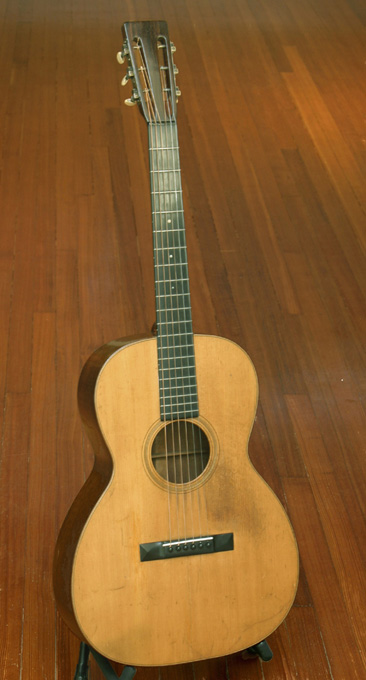 Take Martin’s best era for 12-fret guitars, add more scale length, and you get the best of both worlds–that’s what players say about the 000 sized 12-frets, if they can find one, from the mid to late 20’s. This was the biggest, loudest Martin made for steel strings in this era, with a 25.4 inch scale length, the same scale length as a 30’s D-45! (The 14-fret 000’s of the 30s and later have a shorter, 24.5 inch scale). In no other instrument will you get the resonance (from thin tops and back), combined with the long scale length. It’s a big pre-war Martin 12-fret. That’s why this instrument is a highly sought-after prewar Martin. This crack-free 000-18 has great provenance: acquired from and set up by one of the world’s top Martin experts (in Tuebingen, Germany). 1 7/8” nut. Mahogany back and sides. Adirondack spruce top. Ebony fingerboard. It has original tuners (gear wheel below worm gear, ivoroid buttons), parts, and all original finish. Restoration by TJ Thompson and Dana Bourgeois: correct replacement bridge (ebony pyramid) and bridge plate (maple), and frets replaced (bar frets). Center seam repaired and cleated and touched up (shellack). Neck has been reset. Neck is dead straight, bridge saddle is medium height (allows set up for both higher and lower action if needed in future). Low action, and set up for light or medium gauge strings. The tone could not be better: all the clear separation of the mids that is the hallmark of the 20’s style 18 twelve-fret, but with fuller, louder, rounder bass. One of the most sought-after Martin 12-frets, original finish, crack-free. Restored correctly, cared for, and set up by the world’s best luthiers and vintage Martin experts, and ready to enjoy.
Take Martin’s best era for 12-fret guitars, add more scale length, and you get the best of both worlds–that’s what players say about the 000 sized 12-frets, if they can find one, from the mid to late 20’s. This was the biggest, loudest Martin made for steel strings in this era, with a 25.4 inch scale length, the same scale length as a 30’s D-45! (The 14-fret 000’s of the 30s and later have a shorter, 24.5 inch scale). In no other instrument will you get the resonance (from thin tops and back), combined with the long scale length. It’s a big pre-war Martin 12-fret. That’s why this instrument is a highly sought-after prewar Martin. This crack-free 000-18 has great provenance: acquired from and set up by one of the world’s top Martin experts (in Tuebingen, Germany). 1 7/8” nut. Mahogany back and sides. Adirondack spruce top. Ebony fingerboard. It has original tuners (gear wheel below worm gear, ivoroid buttons), parts, and all original finish. Restoration by TJ Thompson and Dana Bourgeois: correct replacement bridge (ebony pyramid) and bridge plate (maple), and frets replaced (bar frets). Center seam repaired and cleated and touched up (shellack). Neck has been reset. Neck is dead straight, bridge saddle is medium height (allows set up for both higher and lower action if needed in future). Low action, and set up for light or medium gauge strings. The tone could not be better: all the clear separation of the mids that is the hallmark of the 20’s style 18 twelve-fret, but with fuller, louder, rounder bass. One of the most sought-after Martin 12-frets, original finish, crack-free. Restored correctly, cared for, and set up by the world’s best luthiers and vintage Martin experts, and ready to enjoy. -
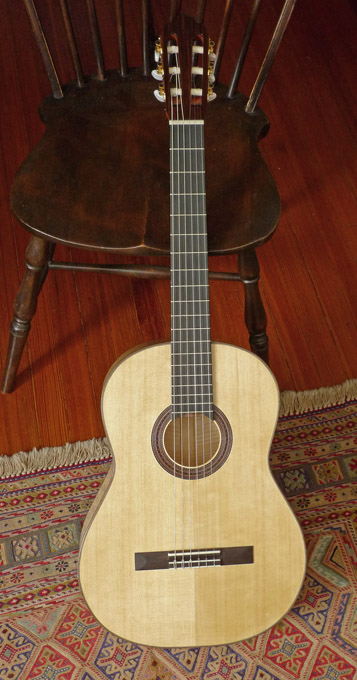 Joseph Redman, based in Abingdon, VA, makes some nice, hand made, yet affordable classical and flamenco guitars. Their low price tags don’t reflect the quality of materials in each instrument. This was a custom order, featuring European Maple back and sides, and all hand French polished by Redman. Nice, rumbling bass response. The Maple tone here, doesn’t show up in the trebles as much as it does in the bass– adding a Maple crispness to the bass strings.
Joseph Redman, based in Abingdon, VA, makes some nice, hand made, yet affordable classical and flamenco guitars. Their low price tags don’t reflect the quality of materials in each instrument. This was a custom order, featuring European Maple back and sides, and all hand French polished by Redman. Nice, rumbling bass response. The Maple tone here, doesn’t show up in the trebles as much as it does in the bass– adding a Maple crispness to the bass strings.- Finish: hand-rubbed French Polish
- 650mm Scale length
- European Maple back and sides
- Canadian Spruce top
- Ebony fretboard
- Neck: Spanish Cedar
- Bindings:
-
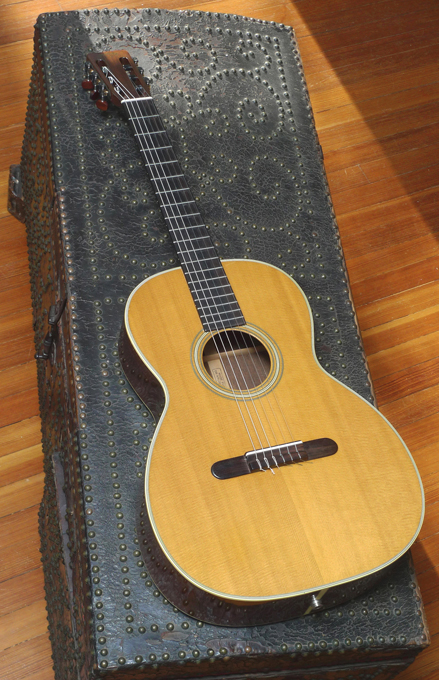 A wonderfully preserved, crack free 12 fret 000-28 Martin, with gorgeous Brazilian rosewood back and sides. The tone of this instrument is wonderful. It stands up to many high end Spanish made classical guitars of the period for Brazilian rosewood warmth. While intentionally not built for concert hall volume, the bass tone and clarity of the trebles on large-bodied Martin nylon strings guitars with Brazilian back and sides is unsurpassed. This instrument is very well set up to play on stage, plugged in, and to record, if desired. It has great high end Gilbert tuners, with black housing, abalone dot and snakewood buttons. (Original tuners, in perfect condition, are in the case, so you can easily replace the originals if desired.) This instrument has an excellent custom engineered stereo pickup system, installed without altering the guitar: The pickup is the undersaddle type, supplied by EMG. The separate mic element is assembled in a foam mounting block with cable, endpin jack, custom made for this guitar. It is unobtrusive in its mounting. Jack is mounted in the endpin hole, so there are no extra holes in the guitar. The output jack is stereo, TRS (Tip wired to pickup, Ring wired to mic, and Sleeve is ground.) The addition of the internal mic adds a realism and depth that no pickup by itself can capture. The EMG pickup is excellent compared to most others in terms of exhibiting less of that harsh piezo sound. The result is a guitar that plays beautifully amplified, or on its own. The Martin “C” has the old elongated Martin 12 fret body. It was offered in the 00-16C, 00-18C and 000-28C in 1962. 1966 saw the last 000-28C. There were not many nylon string, 000-sized 28 models made, and fewer still with the quality of Brazilian rosewood this one has. And the condition on this instrument is stunning. No cracks anywhere, and very little wear at all.
A wonderfully preserved, crack free 12 fret 000-28 Martin, with gorgeous Brazilian rosewood back and sides. The tone of this instrument is wonderful. It stands up to many high end Spanish made classical guitars of the period for Brazilian rosewood warmth. While intentionally not built for concert hall volume, the bass tone and clarity of the trebles on large-bodied Martin nylon strings guitars with Brazilian back and sides is unsurpassed. This instrument is very well set up to play on stage, plugged in, and to record, if desired. It has great high end Gilbert tuners, with black housing, abalone dot and snakewood buttons. (Original tuners, in perfect condition, are in the case, so you can easily replace the originals if desired.) This instrument has an excellent custom engineered stereo pickup system, installed without altering the guitar: The pickup is the undersaddle type, supplied by EMG. The separate mic element is assembled in a foam mounting block with cable, endpin jack, custom made for this guitar. It is unobtrusive in its mounting. Jack is mounted in the endpin hole, so there are no extra holes in the guitar. The output jack is stereo, TRS (Tip wired to pickup, Ring wired to mic, and Sleeve is ground.) The addition of the internal mic adds a realism and depth that no pickup by itself can capture. The EMG pickup is excellent compared to most others in terms of exhibiting less of that harsh piezo sound. The result is a guitar that plays beautifully amplified, or on its own. The Martin “C” has the old elongated Martin 12 fret body. It was offered in the 00-16C, 00-18C and 000-28C in 1962. 1966 saw the last 000-28C. There were not many nylon string, 000-sized 28 models made, and fewer still with the quality of Brazilian rosewood this one has. And the condition on this instrument is stunning. No cracks anywhere, and very little wear at all. -
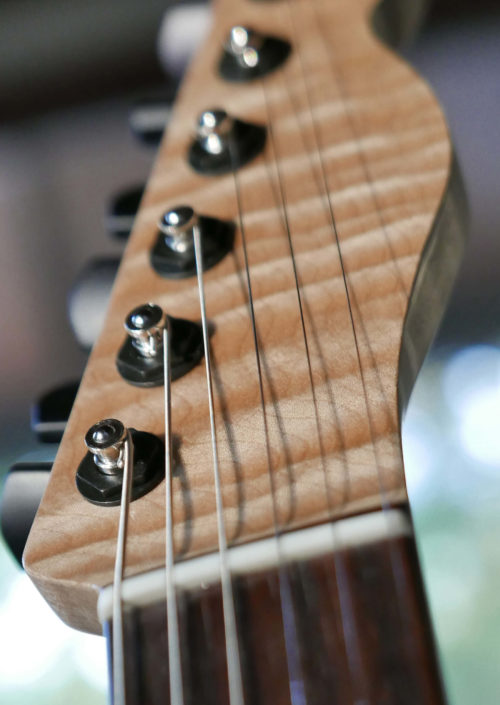 Another original, new, beautiful Custom Tele from master luthier Tony Nobles, based in Wimberly Texas. (Tony has crafted custom guitars for artists ranging in style from Joe Walsh to Alejandro Escovedo.) This guitar was custom made to our specs. And it’s one of one– the only one made with these features. Body: Figured Walnut top over adler Custom high end Musikraft quilted maple neck Width at the Nut: 1-11/16" Width at the Heel: 2-3/16 (55.56mm) Number of Frets: 21 Fret Type: Medium 6105 Finger Board Radius: 10" Body: natural, nitro lacquer finish Back of neck: natural, no finish Front of headstock: natural, nitro lacquer finish Bridge: Hannes by Schaller Non-Tremolo Bridge, #GTH RU-BLACK RUTHENIUM Tuners: Sperzel Trimlok Locking Guitar Tuners 6-in-line Trim-Lok Black Pickups: Harmonic Design "Vintage Plus" bridge and neck pickups
Another original, new, beautiful Custom Tele from master luthier Tony Nobles, based in Wimberly Texas. (Tony has crafted custom guitars for artists ranging in style from Joe Walsh to Alejandro Escovedo.) This guitar was custom made to our specs. And it’s one of one– the only one made with these features. Body: Figured Walnut top over adler Custom high end Musikraft quilted maple neck Width at the Nut: 1-11/16" Width at the Heel: 2-3/16 (55.56mm) Number of Frets: 21 Fret Type: Medium 6105 Finger Board Radius: 10" Body: natural, nitro lacquer finish Back of neck: natural, no finish Front of headstock: natural, nitro lacquer finish Bridge: Hannes by Schaller Non-Tremolo Bridge, #GTH RU-BLACK RUTHENIUM Tuners: Sperzel Trimlok Locking Guitar Tuners 6-in-line Trim-Lok Black Pickups: Harmonic Design "Vintage Plus" bridge and neck pickups -
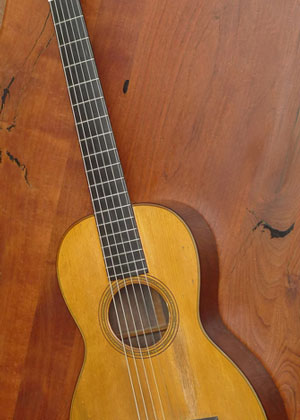 Considered by many to be most charming, intimate, 19th century Martin parlor guitar, the Martin 3-17 features Brazilian Rosewood back and sides, Adirondack spruce top, and Jerome tuners. This particular instrument, with an unbelievably beautiful, lyrical voice, was made in the early 1850’s, as we can tell by several clues. It’s a lot like Mark Twain’s famous Martin 2 ½-17 (see photo). Of course, it has to have the “CF Martin New York” not “CF Martin & Co” stamps– as this one does, to make it a pre-1867 Martin. Also, according to Martin scholars, Jerome tuners seem to have faded out by the late 1850s, to be replaced with similar tuners with a shorter plate and no name stamp. It is unusual on this guitar that the Jerome tuners are German silver, as most of the style 17 guitars have brass tuners. With the “tulip-shaped” tuner buttons, experts date the guitar to the early 1850s. The top is fan braced. Measurements are: body length 17.25″, lower bout width 11.125″, upper bout width 8.25″, overall length 35.75″, scale length just shy of 24 inches. 12 fret cedar neck with ice cream cone heel. Note that the black paint on the back of the neck and back of headstock was removed in some previous century– that does give a nice look at the cedar that would normally be obscured by the black “ebonized” paint. The body of the guitar had some overspray, but it turned out go be one of those fortunate occasions where it was light and really just sitting on top of the original finish, so we are able to easily remove it and reveal the original finish. A couple of small hairline cracks in back, repaired. Top and sides are crack-free. Reproduction ebony bridge. Original bar frets. Original Jerome Silver tuners, with original buttons. Original bracing and bridge plate. “C.F. MARTIN / NEW YORK” hot stamped on back, inside back brace and heel block (but the back stamp is faded). A previous owner of this guitar had a custom hard shell case made– it’s a professional quality, premium case that protects the guitar quite well– it’s heavy and sturdier than most new expensive hard shell cases. Historical interest aside (pre-civil war Martin guitars are rare), this guitar plays wonderfully. It projects the sweetest, but robust, glassy trebles, and clear mids and bass notes. It’s just a joy to play, and it just floats in your hands. (Note: 19th century Martins can be fitted with: gut strings, classical guitar strings, or extra light steel strings– depending on the guitar. It’s really a case-by-case basis, determining whether a particular 19th century Martin can “hold” or “withstand” very light gauge steel strings for example. One size does not fit all. And different 19th century Martins sound better with different strings. In this case, with this particular guitar, extra light steel strings are perfect. It can hold them fine– due to the structure of the top, the bridge plate, and bridge. And it plays and sounds perfect with those strings. This guitar is real find in that regard– not for the collector’s wall but for the player who wants to experience what the original CF Martin felt when he held this instrument in his hands in Nazareth, Pennsylvania, when Abraham Lincoln had not the slightest inkling he’d be in the White House and was just forging a reputation as an outstanding lawyer and earning the nickname of ‘Honest Abe’, and the New York Times was just commencing operations, and the first oil well had just been drilled in the United States by “Colonel” Edwin Drake in Titusville, Pennsylvania– that despite being in C.F. Martin’s state was darn near the old west at the time. In a custom made, professional quality hard shell case.
Considered by many to be most charming, intimate, 19th century Martin parlor guitar, the Martin 3-17 features Brazilian Rosewood back and sides, Adirondack spruce top, and Jerome tuners. This particular instrument, with an unbelievably beautiful, lyrical voice, was made in the early 1850’s, as we can tell by several clues. It’s a lot like Mark Twain’s famous Martin 2 ½-17 (see photo). Of course, it has to have the “CF Martin New York” not “CF Martin & Co” stamps– as this one does, to make it a pre-1867 Martin. Also, according to Martin scholars, Jerome tuners seem to have faded out by the late 1850s, to be replaced with similar tuners with a shorter plate and no name stamp. It is unusual on this guitar that the Jerome tuners are German silver, as most of the style 17 guitars have brass tuners. With the “tulip-shaped” tuner buttons, experts date the guitar to the early 1850s. The top is fan braced. Measurements are: body length 17.25″, lower bout width 11.125″, upper bout width 8.25″, overall length 35.75″, scale length just shy of 24 inches. 12 fret cedar neck with ice cream cone heel. Note that the black paint on the back of the neck and back of headstock was removed in some previous century– that does give a nice look at the cedar that would normally be obscured by the black “ebonized” paint. The body of the guitar had some overspray, but it turned out go be one of those fortunate occasions where it was light and really just sitting on top of the original finish, so we are able to easily remove it and reveal the original finish. A couple of small hairline cracks in back, repaired. Top and sides are crack-free. Reproduction ebony bridge. Original bar frets. Original Jerome Silver tuners, with original buttons. Original bracing and bridge plate. “C.F. MARTIN / NEW YORK” hot stamped on back, inside back brace and heel block (but the back stamp is faded). A previous owner of this guitar had a custom hard shell case made– it’s a professional quality, premium case that protects the guitar quite well– it’s heavy and sturdier than most new expensive hard shell cases. Historical interest aside (pre-civil war Martin guitars are rare), this guitar plays wonderfully. It projects the sweetest, but robust, glassy trebles, and clear mids and bass notes. It’s just a joy to play, and it just floats in your hands. (Note: 19th century Martins can be fitted with: gut strings, classical guitar strings, or extra light steel strings– depending on the guitar. It’s really a case-by-case basis, determining whether a particular 19th century Martin can “hold” or “withstand” very light gauge steel strings for example. One size does not fit all. And different 19th century Martins sound better with different strings. In this case, with this particular guitar, extra light steel strings are perfect. It can hold them fine– due to the structure of the top, the bridge plate, and bridge. And it plays and sounds perfect with those strings. This guitar is real find in that regard– not for the collector’s wall but for the player who wants to experience what the original CF Martin felt when he held this instrument in his hands in Nazareth, Pennsylvania, when Abraham Lincoln had not the slightest inkling he’d be in the White House and was just forging a reputation as an outstanding lawyer and earning the nickname of ‘Honest Abe’, and the New York Times was just commencing operations, and the first oil well had just been drilled in the United States by “Colonel” Edwin Drake in Titusville, Pennsylvania– that despite being in C.F. Martin’s state was darn near the old west at the time. In a custom made, professional quality hard shell case. -
 This extraordinary guitar, completed by C.T. Beitel in June of 1894, is signed and dated by him on the underside of the top. The guitar is in remarkably original condition. And it plays wonderfully. C.T. Beitel (Clemence T. Beitel, 1869-1916) was closely associated with C.F. Martin & Co. in the 1890’s. The Beitels are well known to have been closely associated with the Martin family in these years, both personally (including through marriage) and in the Martin guitar business. According to some correspondence and background research from family members obtained with this guitar, C.T. Beitel was the first American-born person to serve an apprenticeship at Martin Guitars. C.T. Beitel was a cousin to C.A. Zoebisch– who was of course the famous Martin guitar distributor and sometimes-partner of C.F. Martin & Co. in this period. Although this guitar is strikingly faithful to Martin specs, this is most likely one of C.T. Beitel’s guitars made by him to market separately from Martin. It is documented that at least one of the Beitel family had an ongoing guitar making and marketing business in the late 1890’s. Is this Beitel guitar one of the first made under the “Beitel” name? Certainly. Are there others remaining today? There are none known of by us–making this a rare and highly collectible guitar. Similar to a Martin 2-27… but not exactly. More like a cross between a 2-27, a “28” style–because of the wonderful Herringbone purfling/binding on the top– and a 30’s or higher style with its very fancy Jerome tuners.
This extraordinary guitar, completed by C.T. Beitel in June of 1894, is signed and dated by him on the underside of the top. The guitar is in remarkably original condition. And it plays wonderfully. C.T. Beitel (Clemence T. Beitel, 1869-1916) was closely associated with C.F. Martin & Co. in the 1890’s. The Beitels are well known to have been closely associated with the Martin family in these years, both personally (including through marriage) and in the Martin guitar business. According to some correspondence and background research from family members obtained with this guitar, C.T. Beitel was the first American-born person to serve an apprenticeship at Martin Guitars. C.T. Beitel was a cousin to C.A. Zoebisch– who was of course the famous Martin guitar distributor and sometimes-partner of C.F. Martin & Co. in this period. Although this guitar is strikingly faithful to Martin specs, this is most likely one of C.T. Beitel’s guitars made by him to market separately from Martin. It is documented that at least one of the Beitel family had an ongoing guitar making and marketing business in the late 1890’s. Is this Beitel guitar one of the first made under the “Beitel” name? Certainly. Are there others remaining today? There are none known of by us–making this a rare and highly collectible guitar. Similar to a Martin 2-27… but not exactly. More like a cross between a 2-27, a “28” style–because of the wonderful Herringbone purfling/binding on the top– and a 30’s or higher style with its very fancy Jerome tuners.- No “Martin” stamps anywhere
- “C.T. Beitel” paper label on neck block (Martin stamp beneath the label? Uncertain)
- Signed and dated on underside of top: “C.T. Beitel, 6/94, Easton” (i.e. Easton, PA)
- X-braced top
- All original finish; no touch-ups etc
- Pearl inlay around sound hole
- Herringbone purfling around top
- Real Ivory binding, top, and back
- Bound Ivory neck
- Ebony bridge
- Ebony fretboard (bound in Ivory)
- Original Maple bridge plate
- Size: a just bit bigger at lower bout than a Martin “2” size: 12 1/4 inches
- Scale length: 24 3/4 inches
- Body length: 18 3/8 inches
- String spacing at bridge: 2 3/8 inches - Nut width: 1 7/8 inches
- Body depth at bottom of guitar: 4 inches
- Top: Adirondack Spruce
- Back and sides: solid Brazilian Rosewood
- Neck: Cedar
- Headstock: Brazilian Rosewood veneer
- Tuners: original, German-made Jerome tuners, with fancy flower engraving, and oval shaped Ivory tuner buttons. These tuners are typically found only on the highest model Martin guitars of those years
- Tuner buttons: Ivory, oval-shaped
-
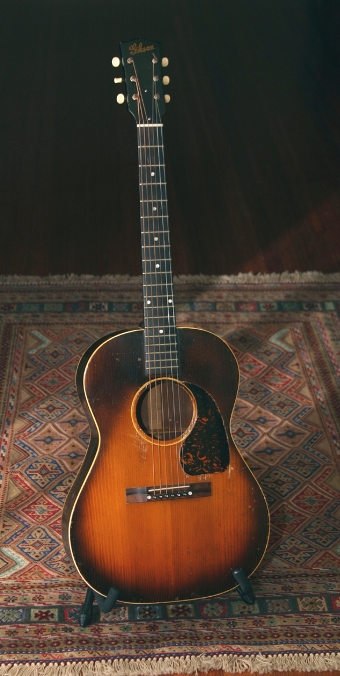 (No serial number or FON, these years often do not have one.) This completely crack-free, Script logo LG-2 is a jewel. A lot of players say the script logo Gibsons from right after the war are better sounding and better-built guitars than the Banner Gibsons. All of the good things about Banners, but with better craftsmanship. All original finish, everywhere. Mahogany back and sides. Spruce top. Not a crack anywhere. 1-3/4" nut. The bridge is an excellent quality rosewood replacement. Original maple plate. Original tuners. Replaced nut and saddle. Rosewood fingerboard shows moderate wear on first couple of frets. Some of that wonderful Gibson 40’s crazing to the finish, but not at all out of hand. Various pick marks, and dings. Original tuners, bridge, plate. Piezo pickup was skillfully de-installed, and endpin jack removed and plugged. One of the finest Script logo LG-2s you’ll find.
(No serial number or FON, these years often do not have one.) This completely crack-free, Script logo LG-2 is a jewel. A lot of players say the script logo Gibsons from right after the war are better sounding and better-built guitars than the Banner Gibsons. All of the good things about Banners, but with better craftsmanship. All original finish, everywhere. Mahogany back and sides. Spruce top. Not a crack anywhere. 1-3/4" nut. The bridge is an excellent quality rosewood replacement. Original maple plate. Original tuners. Replaced nut and saddle. Rosewood fingerboard shows moderate wear on first couple of frets. Some of that wonderful Gibson 40’s crazing to the finish, but not at all out of hand. Various pick marks, and dings. Original tuners, bridge, plate. Piezo pickup was skillfully de-installed, and endpin jack removed and plugged. One of the finest Script logo LG-2s you’ll find. -
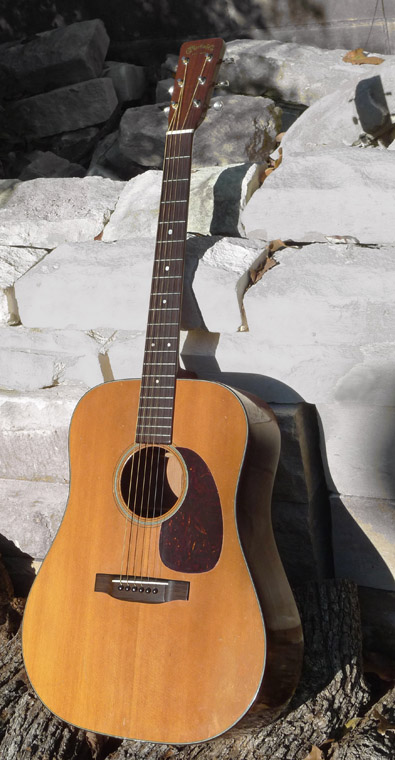 This is another great mid-fifties dread in unbelievable condition. It’s totally crack-free (also, not even a “pick guard” crack). Was acquired in 100% original condition: bridge, saddle, bridge pins, tuners, everything. Just had a neck set– resulting in great action, and tone/projection. With new condition Martin hard shell case.
This is another great mid-fifties dread in unbelievable condition. It’s totally crack-free (also, not even a “pick guard” crack). Was acquired in 100% original condition: bridge, saddle, bridge pins, tuners, everything. Just had a neck set– resulting in great action, and tone/projection. With new condition Martin hard shell case. -
Out of stock
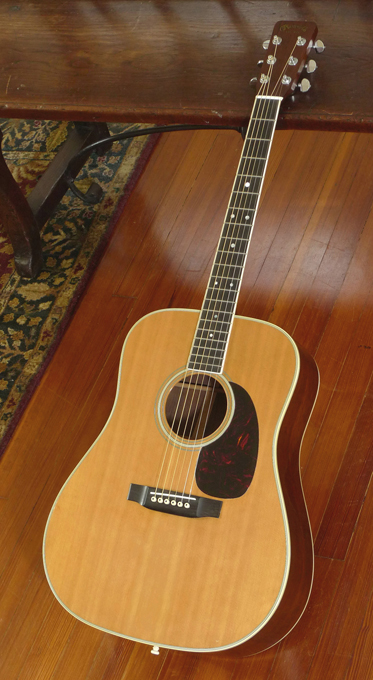 If there is a mid-60’s Brazilian Rosewood D-35 in better original condition out there than this one– it would have to be new. About as close to mint as you can get, this guitar shows little wear. And the Brazilian on back and sides– wonderful specimens, not the “figured” stuff you see on many later 60’s Martins. Not a crack, or hint of crack, anywhere (no, not even the typical “pickguard” crack). Original bridge, tuners, etc. Original frets show almost no wear. All original finish everywhere–and note that the finish does not have any of that “crazing” you often see on the original finishes of mid-60’s Martins. It has never had strap lugs attached. It has the more desirable original tortoise pickguard (Martin changed to black pickguards, later in 1967). Original small maple bridge plate, in original condition. The tone of this guitar, is wonderful. Ringing trebles like the very best brazilian Martin dread’s. And a bass response that shows why Martin brought out this model, in 1965, as an even higher-end model (and with lighter bracing) than the D-28. There are few tiny dings near the edge of the lower bout, on top (too small to photograph well). But a D-35 in better condition than this one would have to be off the factory floor. Action is perfect. Neck straight. Ready to play.
If there is a mid-60’s Brazilian Rosewood D-35 in better original condition out there than this one– it would have to be new. About as close to mint as you can get, this guitar shows little wear. And the Brazilian on back and sides– wonderful specimens, not the “figured” stuff you see on many later 60’s Martins. Not a crack, or hint of crack, anywhere (no, not even the typical “pickguard” crack). Original bridge, tuners, etc. Original frets show almost no wear. All original finish everywhere–and note that the finish does not have any of that “crazing” you often see on the original finishes of mid-60’s Martins. It has never had strap lugs attached. It has the more desirable original tortoise pickguard (Martin changed to black pickguards, later in 1967). Original small maple bridge plate, in original condition. The tone of this guitar, is wonderful. Ringing trebles like the very best brazilian Martin dread’s. And a bass response that shows why Martin brought out this model, in 1965, as an even higher-end model (and with lighter bracing) than the D-28. There are few tiny dings near the edge of the lower bout, on top (too small to photograph well). But a D-35 in better condition than this one would have to be off the factory floor. Action is perfect. Neck straight. Ready to play. -
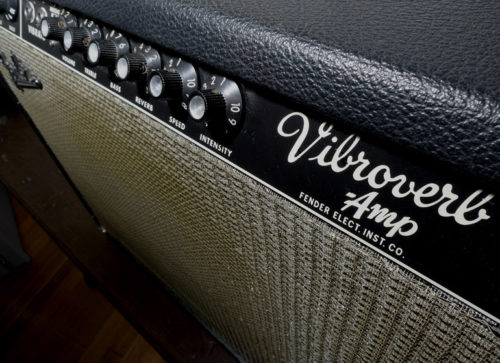 The blackface Vibroverb may be the most sought after Fender amp of all time. Stevie Ray Vaughan is famous for using them. The Vibroverb started as a 2x10 combo with reverb in '63. Then in late '63, Fender decided to switch to a 1x15. This amp has incredible tone. One must hear a black face circuit through an open cabinet JBL 15" speaker to understand the sound. It sounds big and can fill the hall, but it can work as a mid size amp perfect for gigs. This amp is versatile, since the JBL D130 can carry the treble of a telecaster or strat while still having a strong bottom end. Most other amps are either good on highs (Vibrolux, Princeton, Champ), good on lows (Twin, Showman), midrangy (Deluxe, and most new amps) or too big (Marshall double stack). The great Vibroverb is superior to them all. This 1964 Blackface Vibroverb has the original JBL speaker, and the original transformer. The amp also comes with its original footswitch. The only thing done to the amp has been replaced tubes, and the caps. The power cord has been replaced with a grounded three-prong cord.
The blackface Vibroverb may be the most sought after Fender amp of all time. Stevie Ray Vaughan is famous for using them. The Vibroverb started as a 2x10 combo with reverb in '63. Then in late '63, Fender decided to switch to a 1x15. This amp has incredible tone. One must hear a black face circuit through an open cabinet JBL 15" speaker to understand the sound. It sounds big and can fill the hall, but it can work as a mid size amp perfect for gigs. This amp is versatile, since the JBL D130 can carry the treble of a telecaster or strat while still having a strong bottom end. Most other amps are either good on highs (Vibrolux, Princeton, Champ), good on lows (Twin, Showman), midrangy (Deluxe, and most new amps) or too big (Marshall double stack). The great Vibroverb is superior to them all. This 1964 Blackface Vibroverb has the original JBL speaker, and the original transformer. The amp also comes with its original footswitch. The only thing done to the amp has been replaced tubes, and the caps. The power cord has been replaced with a grounded three-prong cord. -
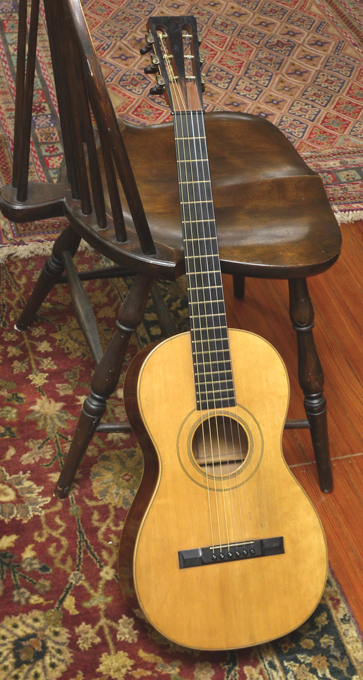 Circa 1860 parlor guitar style 1 built by well known luthier, James Ashborn of Wolcottville, CT, for William hall & son music store. Brazilian rosewood back and sides; Adirondack top; maple binding. This guitar is crack free save for a couple of minor finish cracks on back, and is 100% original, including all original finish, and down to original nut, original bridge (and saddle) that has never been off the guitar, and original bridge pins. From a just-published article in Vintage Guitar magazine: “Ashborn's design for the guitar was quite innovative for the early 19th century. Instead of making guitars fashioned after the typical parlor-style guitars, he made them in the Spanish style, by taking interior bracing cues from the Spanish while retaining the body of the English guitars. This included a fan brace pattern rather than the more common ladder pattern Ashborn guitars have a very complex dovetail V joint for attaching the head to the neck. The headstock was cut in roughly five steps, using some kind of tracing router, as suggested by the chatter marks on the inside ears of the pegbox. In addition to the complex head design, Ashborn made his own tuning machines in-house. They're made of brass, very much like contemporary machines, with worm gears, cog gears, and rollers. … Ashborn's shop was extremely advanced for its time, having a great deal of know-how and technology. Ashborn understood the need to have the technology as well as the skill, but more importantly he discovered a new way of making high-quality instruments that were affordable. He was able to create a factory environment where workers did what they were good at and, with practice, became very fast and consistent. With a new level of consistency in mass production, he created the path followed by other companies such as Martin, Gibson, and Taylor. Using designs ahead of his time, he was able to bring the sound and change to people who otherwise never would have been able to acquire an instrument of this quality.” This beautiful all-original and crack-free Ashborn guitar is one of the best-preserved examples in existence.
Circa 1860 parlor guitar style 1 built by well known luthier, James Ashborn of Wolcottville, CT, for William hall & son music store. Brazilian rosewood back and sides; Adirondack top; maple binding. This guitar is crack free save for a couple of minor finish cracks on back, and is 100% original, including all original finish, and down to original nut, original bridge (and saddle) that has never been off the guitar, and original bridge pins. From a just-published article in Vintage Guitar magazine: “Ashborn's design for the guitar was quite innovative for the early 19th century. Instead of making guitars fashioned after the typical parlor-style guitars, he made them in the Spanish style, by taking interior bracing cues from the Spanish while retaining the body of the English guitars. This included a fan brace pattern rather than the more common ladder pattern Ashborn guitars have a very complex dovetail V joint for attaching the head to the neck. The headstock was cut in roughly five steps, using some kind of tracing router, as suggested by the chatter marks on the inside ears of the pegbox. In addition to the complex head design, Ashborn made his own tuning machines in-house. They're made of brass, very much like contemporary machines, with worm gears, cog gears, and rollers. … Ashborn's shop was extremely advanced for its time, having a great deal of know-how and technology. Ashborn understood the need to have the technology as well as the skill, but more importantly he discovered a new way of making high-quality instruments that were affordable. He was able to create a factory environment where workers did what they were good at and, with practice, became very fast and consistent. With a new level of consistency in mass production, he created the path followed by other companies such as Martin, Gibson, and Taylor. Using designs ahead of his time, he was able to bring the sound and change to people who otherwise never would have been able to acquire an instrument of this quality.” This beautiful all-original and crack-free Ashborn guitar is one of the best-preserved examples in existence. -
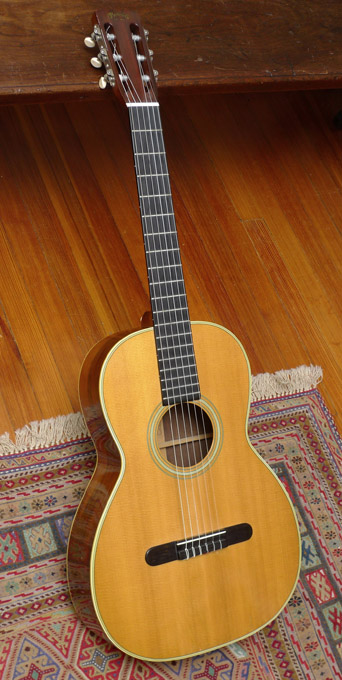 Another wonderful instrument with top grade Brazilian Rosewood back and sides. The Brazilian rosewood on this in instrument is more figured on the sides, and the back shows wonderful bookmatched figuring. This is an all-original guitar. There are no cracks that go through the wood. There are several finish/superficial cracks in the finish, one on the top near the bottom/endpin area, and one on the back. And a bit of crazing in the top finish. Set-up and playability is great. Wonderful full tonal range up and down the fretboard.
Another wonderful instrument with top grade Brazilian Rosewood back and sides. The Brazilian rosewood on this in instrument is more figured on the sides, and the back shows wonderful bookmatched figuring. This is an all-original guitar. There are no cracks that go through the wood. There are several finish/superficial cracks in the finish, one on the top near the bottom/endpin area, and one on the back. And a bit of crazing in the top finish. Set-up and playability is great. Wonderful full tonal range up and down the fretboard. -
Out of stock
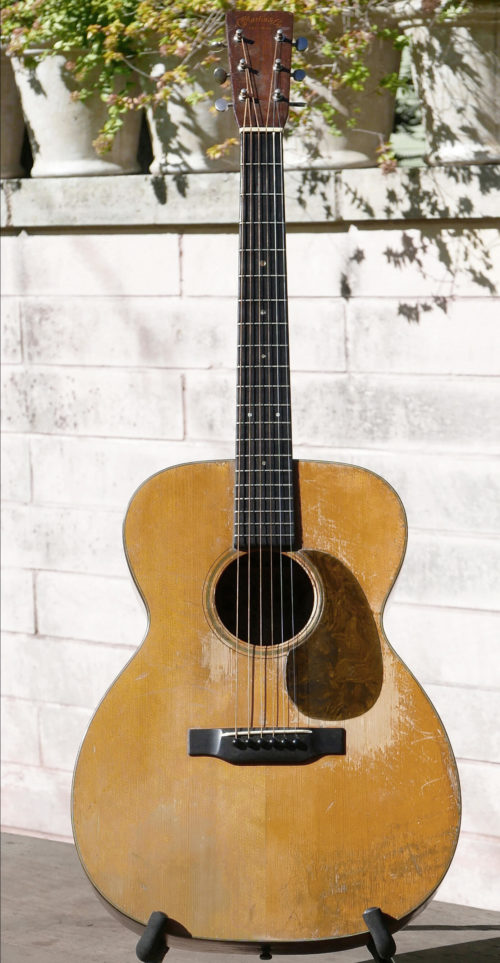 Impossible to mistake this guitar for a “1937 Authentic” or some such “recreation”. This 000-18 left the Martin factory in Nazareth, in 1937, indeed. And it’s been well-played since. More importantly, the tone is stellar– all you would expect from this style, this year, and more. Its bass response is similar to the best prewar D-18s. And it has the unmistakable string separation that only prewar Martins have. This instrument was in the family of its original owner until we obtained it. The original owner was Leroy Jenkins, a blind country artist in the 1950’s, in Texas, on the Dude label.
Impossible to mistake this guitar for a “1937 Authentic” or some such “recreation”. This 000-18 left the Martin factory in Nazareth, in 1937, indeed. And it’s been well-played since. More importantly, the tone is stellar– all you would expect from this style, this year, and more. Its bass response is similar to the best prewar D-18s. And it has the unmistakable string separation that only prewar Martins have. This instrument was in the family of its original owner until we obtained it. The original owner was Leroy Jenkins, a blind country artist in the 1950’s, in Texas, on the Dude label. -
Out of stock
 1957 Martin D-18 Guitar with Original Red Spruce Top Read the full description below. If you're interested in this guitar, please call 512.922.8596 or contact us here.
1957 Martin D-18 Guitar with Original Red Spruce Top Read the full description below. If you're interested in this guitar, please call 512.922.8596 or contact us here. -
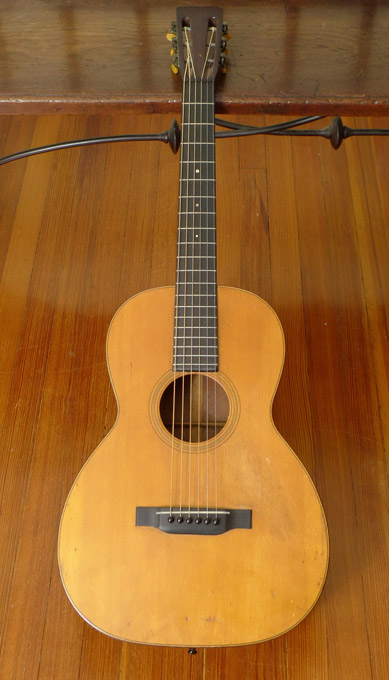 A great sounding 00-18, from the era when 18’s were light as a feather and have the resonance that result in singular tone– and this one from the time when Martin had just moved away from the pyramid bridge and to the belly bridge.
A great sounding 00-18, from the era when 18’s were light as a feather and have the resonance that result in singular tone– and this one from the time when Martin had just moved away from the pyramid bridge and to the belly bridge.- Original finish (with a bit of overspray, only on the area below the soundhole (typical light overspray where there was pick wear)
- Has just had neck set, here, perfect job
- Has just been refret, with period correct Bar frets obtained from TJ Thompson
- New, exact duplicate bridge made (it had its original belly bridge, but it had a crack and we preferred to replace the bridge with a perfect reproduction ebony belly bridge. New bridge, is on exact, correct footprint of original bridge
- the top of the guitar is crack-free
- the back of the guitar is crack-free
- Repaired side cracks, on both treble and bass sides
-
 The instrument features the original ebony bridge (full height), original tuners, original ivory saddle and nut, original maple bridge plate. Ebony fretboard. Bar frets. Thin, Soft-V neck. Finish is original. There is some overspray on the top, which is confined mainly to below the soundhole (over about the same size area, as what a pickguard would cover–but it never had a pickguard), and a bit below the bridge, and very very light on other areas of the top. Apparently a previous owner wanted to address the pick/finger wear and a repaired crack below the bridge. It's generally unobtrusive, no effect on the color of the top, and not noticeable from a few feet. Also, some light overspray on back and sides. As overspray goes, it has minimal effect on the appearance. Neck, and head have no overspray at all. There is one crack on the instrument from the bridge to the bottom of the guitar, but it's well repaired (it's about a half-inch from the center seam, below the bridge). Also about a 2 1/2 inch shallow crack/finish crack near where the fretboard meets the top (about 1/8 inch from the fretboard), on low-E side (does not go through–It is not visible on underside of top). There is a small indentation on the side rosewood (about one inch in area, on the side/lower, stable.) 1-7/8 inch nut. Action is 3/32 inch high E string/12th fret. 4/32 low E string… just right to get that full, cascading Brazilian tone from this fine 0-21.
The instrument features the original ebony bridge (full height), original tuners, original ivory saddle and nut, original maple bridge plate. Ebony fretboard. Bar frets. Thin, Soft-V neck. Finish is original. There is some overspray on the top, which is confined mainly to below the soundhole (over about the same size area, as what a pickguard would cover–but it never had a pickguard), and a bit below the bridge, and very very light on other areas of the top. Apparently a previous owner wanted to address the pick/finger wear and a repaired crack below the bridge. It's generally unobtrusive, no effect on the color of the top, and not noticeable from a few feet. Also, some light overspray on back and sides. As overspray goes, it has minimal effect on the appearance. Neck, and head have no overspray at all. There is one crack on the instrument from the bridge to the bottom of the guitar, but it's well repaired (it's about a half-inch from the center seam, below the bridge). Also about a 2 1/2 inch shallow crack/finish crack near where the fretboard meets the top (about 1/8 inch from the fretboard), on low-E side (does not go through–It is not visible on underside of top). There is a small indentation on the side rosewood (about one inch in area, on the side/lower, stable.) 1-7/8 inch nut. Action is 3/32 inch high E string/12th fret. 4/32 low E string… just right to get that full, cascading Brazilian tone from this fine 0-21. -
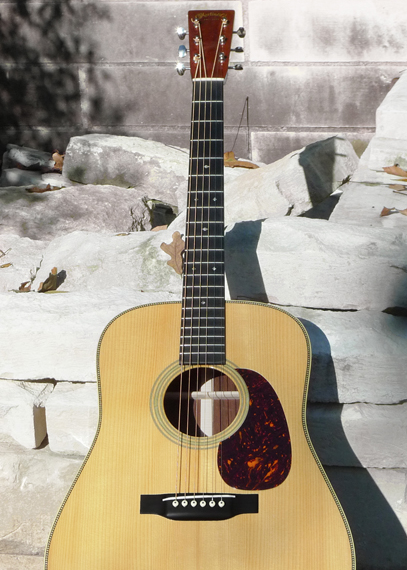 Martin has refined their “Authentic” series 1930’s recreations. When the first D-28A came out a about 5 years ago, it was Brazilian rosewood, with a price tag north of $20K. So when Martin decided to produce a Madagascar rosewood version, it was very welcome. In fact Martin learned from the earlier “Authentic” models and this guitar, one of the very first D-28 Authentics’s made with Madagascar rosewood, is a best of the breed– a recreation of the original 1937 D-28 model but now offered with Madagascar rosewood back and sides. And this instrument has a particularly good set of Madagascar.
Martin has refined their “Authentic” series 1930’s recreations. When the first D-28A came out a about 5 years ago, it was Brazilian rosewood, with a price tag north of $20K. So when Martin decided to produce a Madagascar rosewood version, it was very welcome. In fact Martin learned from the earlier “Authentic” models and this guitar, one of the very first D-28 Authentics’s made with Madagascar rosewood, is a best of the breed– a recreation of the original 1937 D-28 model but now offered with Madagascar rosewood back and sides. And this instrument has a particularly good set of Madagascar.- It’s in virtually unplayed, mint condition.
- Forward shifted hand-scalloped X-bracing
- Fingerboard Width At Nut: 1 3/4''
- Mahogany Blocks/Dovetail Neck Joint - Hide Glue
- Top: Solid Adirondack Spruce
- Top Braces: Solid Adirondack Spruce 5/16''
- Back Material: Solid Madagascar Rosewood
- Back Purfling: 28 Style Zig-Zag (Authentic)
- Side Material: Solid Madagascar Rosewood
- Neck Shape: Authentic 1937 Barrel & Heel
- Scale Length: 25.4''
- Bridge String Spacing: 2-5/16''
- Saddle: 16'' Radius/Long Bone
-
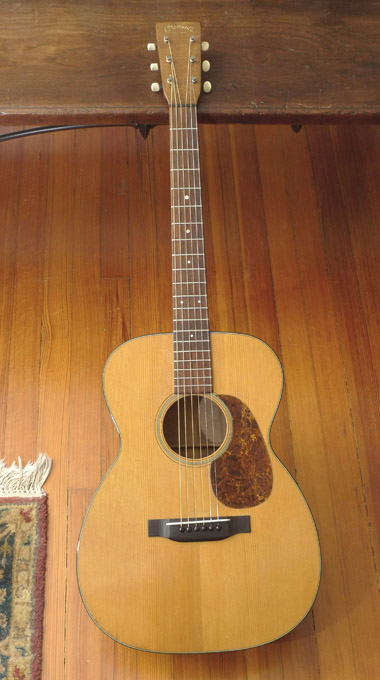 This is a prime example of why the pre-war, scalloped brace Martins made in 1943 in particular are the best sounding Martins ever: the ebony truss rod in the neck (instead of a metal truss rod– due to wartime metal rationing), the even more finely scalloped tone bars, and lack of metal tuner post bushings, all contribute to the lightness of build, and the robust tone, resonance and sustain you won’t find on any other Martin (not even the mid-30’s Martins). This guitar, seemingly light as a feather, plays like a dream, and is particularly resonant, and wonderful, for fingerpicking. (Martins from this year, often have a thinner finish, as does this one, which also contributes to its almost Shaker-like simplicity and beauty.) All original finish still in great shape. It has just had a new, Brazilian rosewood bridge made (from 100 year old, old-growth Brazilian rosewood, to the exact shape and footprint of the original which had a crack and was better replaced) by Tony Nobles (original bridge will ship, in the case). The bridge is hide-glued on, naturally. Aside from the typical B-string area “pickguard crack”, now well repaired and a non-issue, the top of the guitar is crack free. There is one well-repaired crack on the back. There was an old input jack right below the end pin, now filled expertly by Nobles (but no evidence of any pickups etc inside the guitar).
This is a prime example of why the pre-war, scalloped brace Martins made in 1943 in particular are the best sounding Martins ever: the ebony truss rod in the neck (instead of a metal truss rod– due to wartime metal rationing), the even more finely scalloped tone bars, and lack of metal tuner post bushings, all contribute to the lightness of build, and the robust tone, resonance and sustain you won’t find on any other Martin (not even the mid-30’s Martins). This guitar, seemingly light as a feather, plays like a dream, and is particularly resonant, and wonderful, for fingerpicking. (Martins from this year, often have a thinner finish, as does this one, which also contributes to its almost Shaker-like simplicity and beauty.) All original finish still in great shape. It has just had a new, Brazilian rosewood bridge made (from 100 year old, old-growth Brazilian rosewood, to the exact shape and footprint of the original which had a crack and was better replaced) by Tony Nobles (original bridge will ship, in the case). The bridge is hide-glued on, naturally. Aside from the typical B-string area “pickguard crack”, now well repaired and a non-issue, the top of the guitar is crack free. There is one well-repaired crack on the back. There was an old input jack right below the end pin, now filled expertly by Nobles (but no evidence of any pickups etc inside the guitar).- Original bridge plate, in fine condition. Original Frets.
- Original tuners (it looks like at one point there were other tuners on the guitar… with a few old screw holes filled.)
- Has never had strap lug attached to heel
- Top shows no “bellying”. Natural shape and slight arch is textbook perfect.
-
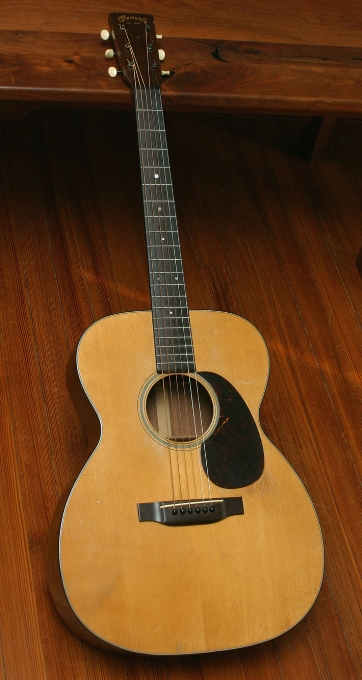 A rare, 100% original pre-war Martin. Not a crack anywhere. And though it of course has the 1-11/16 inch nut, it plays remarkably like the wider nut mid-30's 000-18's due to the generous (original) string spacing at the nut. Original finish. Neck has never been re-set. Original Ebony nut, ivory saddle, full height original bridge. Original tuners. Original plastic tuner buttons in great condition (no shrinkage). Lack of tuner ferrels of course (because of war-time metal shortages). Brazilian rosewood bridge, fingerboard, and peghead veneer. Scalloped braces. Original bridge plate. Frets show minor/normal wear. It shows light/normal pick wear around the soundhole (nothing anywhere near down to bare wood). Other minor superficial scratches on back, and sides. Bass tone and volume is impressive-the characteristic of war-time "pre-war" Martins, that featured more deeply scalloped braces. Many believe these more deeply scalloped braces found only in these years give them better tone than the mid-30s Martins. It does need a standard neck set. It's not egregiously out of set, action is a bit high at 12th fret. But due the originality of the instrument, original ivory saddle still hide glued-in, etc., we believe the buyer would want to set the neck to their liking. (We would be happy to set the neck for the new owner if desired, at no additional charge, after purchase.) The tone: gold standard pre-war 000-18. Loud, dark, crisp, and clear.
A rare, 100% original pre-war Martin. Not a crack anywhere. And though it of course has the 1-11/16 inch nut, it plays remarkably like the wider nut mid-30's 000-18's due to the generous (original) string spacing at the nut. Original finish. Neck has never been re-set. Original Ebony nut, ivory saddle, full height original bridge. Original tuners. Original plastic tuner buttons in great condition (no shrinkage). Lack of tuner ferrels of course (because of war-time metal shortages). Brazilian rosewood bridge, fingerboard, and peghead veneer. Scalloped braces. Original bridge plate. Frets show minor/normal wear. It shows light/normal pick wear around the soundhole (nothing anywhere near down to bare wood). Other minor superficial scratches on back, and sides. Bass tone and volume is impressive-the characteristic of war-time "pre-war" Martins, that featured more deeply scalloped braces. Many believe these more deeply scalloped braces found only in these years give them better tone than the mid-30s Martins. It does need a standard neck set. It's not egregiously out of set, action is a bit high at 12th fret. But due the originality of the instrument, original ivory saddle still hide glued-in, etc., we believe the buyer would want to set the neck to their liking. (We would be happy to set the neck for the new owner if desired, at no additional charge, after purchase.) The tone: gold standard pre-war 000-18. Loud, dark, crisp, and clear. -
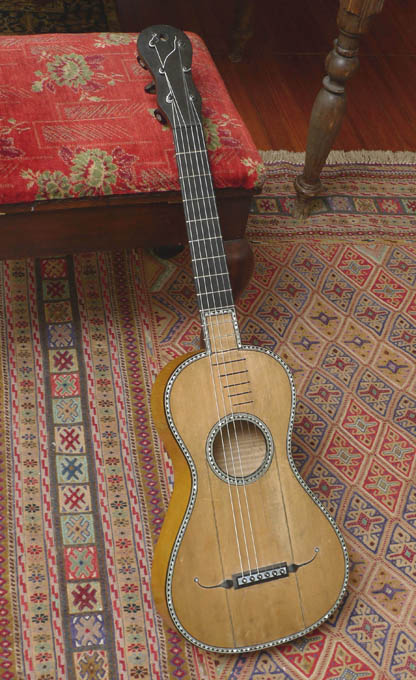 This fine and early example of the French guitar was made in Mirecourt, France, around 1800 to 1810. And sold through the famous Parisian dealer Koliker. It is a rare early example, as indicated by its rectangular bridge that does not have a separate saddle, but uses the top edge of the ebony rectangle as the saddle (this feature places it circa 1800, not like the more common 1820-1840 French guitars that have a more modern style bridge including a regular saddle). But for all its rarity, and exoticism to modern eyes, the most salient feature of this guitar is that it plays wonderfully. This is no museum piece to hang on a wall or shelf. This guitar is to play and enjoy. It plays beautifully, with all frets in tune. With no buzzing... I have had guitars from the 1960’s that do not play as well, in tune, and sound as well as this one. Even the action is perfect. The guitar has a wonderful tone, with a sweetness and brightness from the maple, and full bass response.
This fine and early example of the French guitar was made in Mirecourt, France, around 1800 to 1810. And sold through the famous Parisian dealer Koliker. It is a rare early example, as indicated by its rectangular bridge that does not have a separate saddle, but uses the top edge of the ebony rectangle as the saddle (this feature places it circa 1800, not like the more common 1820-1840 French guitars that have a more modern style bridge including a regular saddle). But for all its rarity, and exoticism to modern eyes, the most salient feature of this guitar is that it plays wonderfully. This is no museum piece to hang on a wall or shelf. This guitar is to play and enjoy. It plays beautifully, with all frets in tune. With no buzzing... I have had guitars from the 1960’s that do not play as well, in tune, and sound as well as this one. Even the action is perfect. The guitar has a wonderful tone, with a sweetness and brightness from the maple, and full bass response.- All original finish on the guitar
- Flamed solid Maple back and sides
- Spruce top, with no finish on the spruce… this is a characteristic of guitars from this time and place. While the back and sides of the guitar were French polished, the spruce top was left as natural wood, with no finish.
- One of the friction pegs is a modern replacement
- The two dark splices on the soundboard are later, but still 19th century, restorations, done as decorative flourishes.
- Scale length: 64.3 cm
- Length of body: 43.3 cm
- Koliker, Luthier Rue Croix-des-Petits Champs No. 24 A. Paris